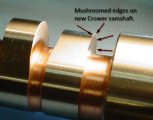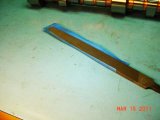This document was in a sub folder for my Dynomation sim software.
COMP Cams® Special Services
A partial listing of the most common high end treatments and
special processes you can order for your COMP Cams® camshaft.
Additional services are available; contact us for any special needs.
Camshaft Surface Preparations
Nitriding − Part #1-111-1
This is the most effective process for extending the life of a high
performance flat tappet camshaft. Nitriding increases the hardness
of the camshaft surface metal by physically injecting nitrogen
“needles” into the surface of the lobes and journals to increase their
resistance to wear.
Camshaft Micropolishing − Part #1-114-1
This procedure removes microscopic imperfections in the surface
of the metal. Micropolishing can further increase the durability of
the camshaft and can be performed to only the camshaft lobes or
all wear surfaces.
Xtreme Surface Finish Enhancement − Part #1-137-1
Our highest-quality finishing process involving considerably more
polishing than any other procedure. This is most commonly used in
steel-on-steel contact valve train situations, such as high end circle
track flat tappet camshafts where billet materials have repeated
contact in extremely high RPM environments.
Precision Camshaft Measurement
Basic Camshaft Profiling − Part #1-126-1
Performed on two lobes of any camshaft, the component is
measured to determine its lift, duration and lobe centerline
specifications.
Adcole Camshaft Profiling − Part #1-125-1
Our highest precision camshaft measuring device, the Adcole,
checks all 16 camshaft lobes to determine that the cam meets all
specifications requested by the customer. The Adcole measures
camshaft specifications to 0.00001 of an inch.
Special Operations
Replacement of the Camshaft Dowel Pin − Part #1-120-1
This is a process which repairs camshafts when the current dowel
pin has either been sheared off or damaged in some manner. The
old dowel pin (or remaining part) is removed by machining and a
new dowel pin is inserted.
Installation of Dual Dowel Pins − Part #1-121-1
For certain applications, dual dowel pins can be installed to further
ensure that the camshaft and timing gear connection are secure.
This is most commonly done with early model Ford V8s and classic
Chrysler Hemi engines. The timing gear can also be machined to
adapt to this new configuration.
Drilling and Tapping Camshaft Nose − Part #1-136-1
A process performed on Viper camshafts, the nose of the camshaft
is drilled and then tapped to convert from a single timing gear bolt-
up to a three-bolt aftermarket timing chain set. This allows for a
wider selection of timing sets.
Machining a Rear Camshaft Journal Groove − Part #1-119-1
A process commonly performed on 1965-66 Big Block 396c.i.
Chevrolet engines, which features oiling systems that require a
groove be cut into the rear journal of the camshaft. This was a two-
year only condition, not required in all 1967 and newer Big Block
Chevrolet engines.
Machining of the Rear Pump Drive − Part #1-116-1
Allows sprint car-style engines to run the fuel pump from the rear of
the camshaft rather than traditional placements.
Side Cutting of Camshaft Lobes − Part #1-127-1
A process often requested that helps to keep the lifters from
making contact with adjacent lobes when the engine’s lifter bores
have been enlarged.
Sleeving of the Camshaft Journal − Part #1-132-1
Most popular with Ford Windsor engine roller bearing camshaft
applications, a sleeve is placed around the standard rear journal to
increase the size of the journal, making it compatible with rear roller
bearing usage.
Fuel Pump Lobe Regrinding − Part #1-147-1
A refinishing process used to clean up a fuel pump lobe which may
have been damaged or is showing excessive wear.
Chamfer/Edge Break − Part #1-122-1
Common in NASCAR and other professional series, this process
lightly chamfers the lobe surface edges on each side. This edge
break minimizes corner stress concentration, resulting in improved
endurance whenever follower contact runs close to the side of the
lobe. Highly recommended in any application with narrow lobes.
My Crower camshaft needed this last service "Chamfer/Edge Break − Part #1-122-1" because of the mushrooming metal on the side of the lobes. I used a file to carefully remove the metal and leave a small radius on every lobe.


.
COMP Cams® Special Services
A partial listing of the most common high end treatments and
special processes you can order for your COMP Cams® camshaft.
Additional services are available; contact us for any special needs.
Camshaft Surface Preparations
Nitriding − Part #1-111-1
This is the most effective process for extending the life of a high
performance flat tappet camshaft. Nitriding increases the hardness
of the camshaft surface metal by physically injecting nitrogen
“needles” into the surface of the lobes and journals to increase their
resistance to wear.
Camshaft Micropolishing − Part #1-114-1
This procedure removes microscopic imperfections in the surface
of the metal. Micropolishing can further increase the durability of
the camshaft and can be performed to only the camshaft lobes or
all wear surfaces.
Xtreme Surface Finish Enhancement − Part #1-137-1
Our highest-quality finishing process involving considerably more
polishing than any other procedure. This is most commonly used in
steel-on-steel contact valve train situations, such as high end circle
track flat tappet camshafts where billet materials have repeated
contact in extremely high RPM environments.
Precision Camshaft Measurement
Basic Camshaft Profiling − Part #1-126-1
Performed on two lobes of any camshaft, the component is
measured to determine its lift, duration and lobe centerline
specifications.
Adcole Camshaft Profiling − Part #1-125-1
Our highest precision camshaft measuring device, the Adcole,
checks all 16 camshaft lobes to determine that the cam meets all
specifications requested by the customer. The Adcole measures
camshaft specifications to 0.00001 of an inch.
Special Operations
Replacement of the Camshaft Dowel Pin − Part #1-120-1
This is a process which repairs camshafts when the current dowel
pin has either been sheared off or damaged in some manner. The
old dowel pin (or remaining part) is removed by machining and a
new dowel pin is inserted.
Installation of Dual Dowel Pins − Part #1-121-1
For certain applications, dual dowel pins can be installed to further
ensure that the camshaft and timing gear connection are secure.
This is most commonly done with early model Ford V8s and classic
Chrysler Hemi engines. The timing gear can also be machined to
adapt to this new configuration.
Drilling and Tapping Camshaft Nose − Part #1-136-1
A process performed on Viper camshafts, the nose of the camshaft
is drilled and then tapped to convert from a single timing gear bolt-
up to a three-bolt aftermarket timing chain set. This allows for a
wider selection of timing sets.
Machining a Rear Camshaft Journal Groove − Part #1-119-1
A process commonly performed on 1965-66 Big Block 396c.i.
Chevrolet engines, which features oiling systems that require a
groove be cut into the rear journal of the camshaft. This was a two-
year only condition, not required in all 1967 and newer Big Block
Chevrolet engines.
Machining of the Rear Pump Drive − Part #1-116-1
Allows sprint car-style engines to run the fuel pump from the rear of
the camshaft rather than traditional placements.
Side Cutting of Camshaft Lobes − Part #1-127-1
A process often requested that helps to keep the lifters from
making contact with adjacent lobes when the engine’s lifter bores
have been enlarged.
Sleeving of the Camshaft Journal − Part #1-132-1
Most popular with Ford Windsor engine roller bearing camshaft
applications, a sleeve is placed around the standard rear journal to
increase the size of the journal, making it compatible with rear roller
bearing usage.
Fuel Pump Lobe Regrinding − Part #1-147-1
A refinishing process used to clean up a fuel pump lobe which may
have been damaged or is showing excessive wear.
Chamfer/Edge Break − Part #1-122-1
Common in NASCAR and other professional series, this process
lightly chamfers the lobe surface edges on each side. This edge
break minimizes corner stress concentration, resulting in improved
endurance whenever follower contact runs close to the side of the
lobe. Highly recommended in any application with narrow lobes.
My Crower camshaft needed this last service "Chamfer/Edge Break − Part #1-122-1" because of the mushrooming metal on the side of the lobes. I used a file to carefully remove the metal and leave a small radius on every lobe.


.
